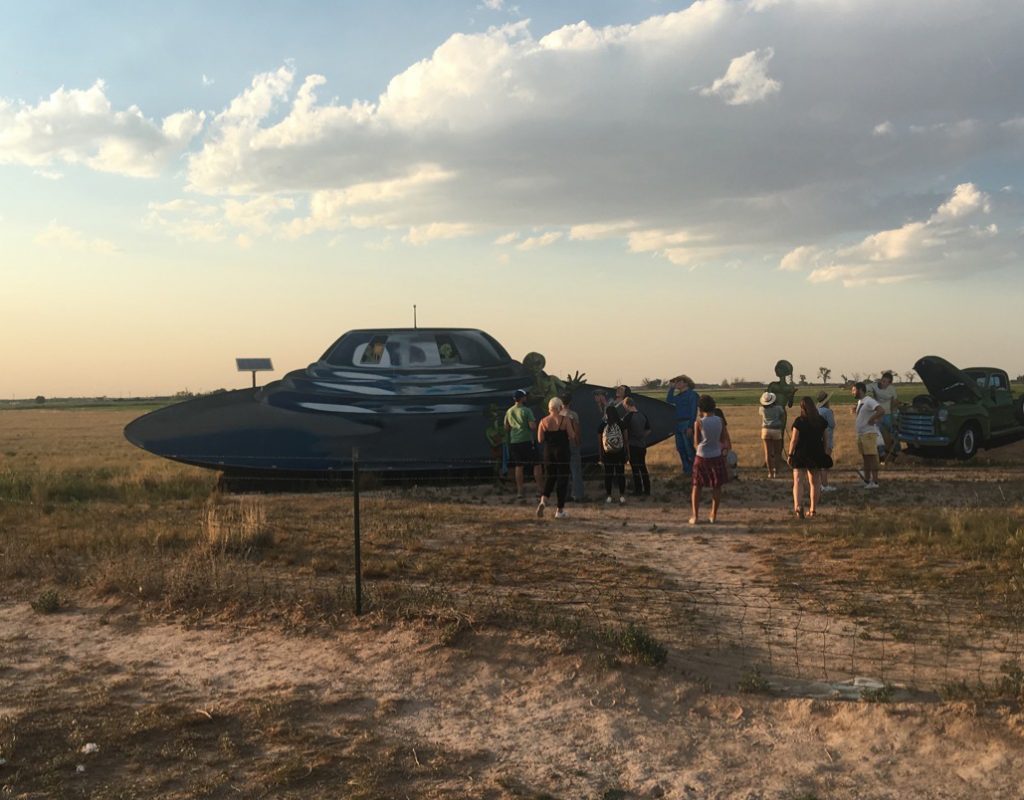Or: How Butcher Bird Studios worked with Adobe Premiere Pro’s Team Projects and the LumaForge Jellyfish to conquer alien challenges and launch an online pilot for Airbnb and National Geographic.
Butcher Bird Studios
Butcher Bird Studios has gained a reputation for doing unusual projects with new technologies in harsh environments. It’s a high-stress, high-wire trifecta that’s as exhilarating as it is terrifying. Now we just assume that we’re gonna get called with unexpected challenges and impossible deadlines. And you know what? Since working out the tools to make everything possible, we’ve grown to love these projects.
The Mission

Last summer, one of our favorite agencies, TBWA\Chiat\Day, asked the Butcher Bird team to solve a big interesting challenge. We would need to create a series of live stream pilots sponsored by National Geographic and Airbnb. We would also need to create a companion documentary, and a ton of digital companion pieces. This all had to be done on a social media budget, over the course of four days.
The concept for the show (“Live From”) was really cool. Experience a hyper-local version of an event and location through the eyes of someone who lives there, as well as through the experience of an expert host. On-camera guides would be supplied by Airbnb and Nat Geo. They were Timothy, an Airbnb host, and Asher, an official National Geographic Explorer.
A truly nonpareil event served as the launch board for the pilot episode. It was the 70th anniversary of the “Roswell UFO Festival.” Our live shows, documentary and companion media pieces would be shot in the desert. In July. Two hundred miles from the nearest major metropolis. Biggest concerns: bandwidth and workflow. First item on the gear list: Gatorade.
Challenges
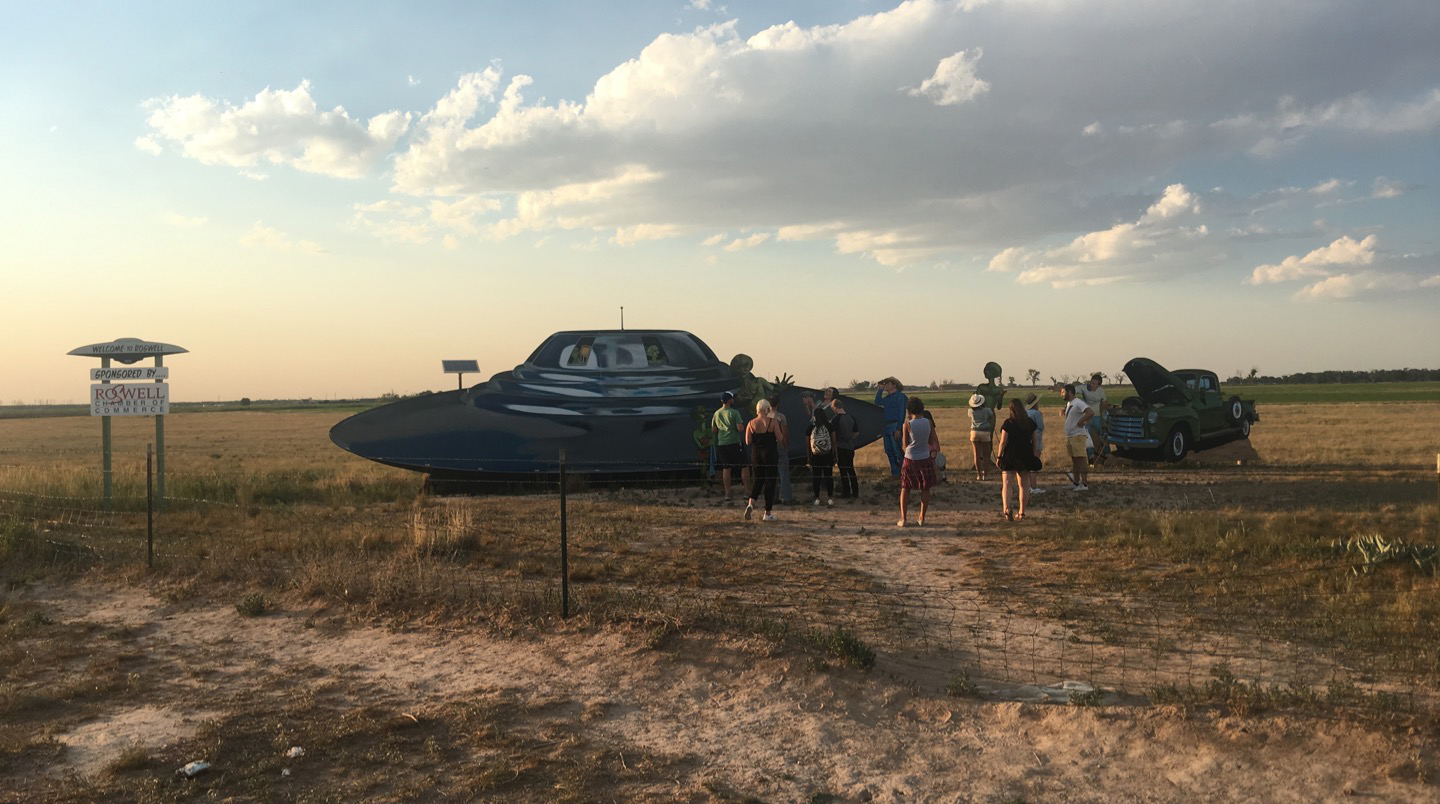
We had already been crazy enough to shoot Airbnb’s National Parks 100th Anniversary live streaming experience the previous year. We had coast-to-coast views from sunrise to sunset in some of the USA’s most beautiful vistas. Bandwidth and batteries were just a couple of the challenges we had solved for those 12 continuous hours of live streaming. So we were totally game for the challenges of Roswell. However, the modest budget for this new project was daunting to say the least.
Our deliverables required: on Saturday, the biggest day of the festival, three half-hour live streams (co-hosted on the Facebook pages of Airbnb and National Geographic); on Monday, the day after the end of the festival, posting a short-form companion documentary; and a continuous output of interesting photos and media pieces beginning the day before the festival and posting throughout the event.
We had to solve two major challenges with limited dollars. We had short turnaround times for our content AND needed to cover an event with thousands of attendees over the course of three days. All the while, we would be supplying multiple aspect ratios (including vertical video) for sites ranging from Instagram to YouTube.
Approach
In addition to being a director, I’m also a lifelong tech geek. What kept going through my head during the first project briefing was “parallel processing.” We wouldn’t have the luxury of finishing one task before starting the next. Whatever we came up with for our post workflow had to allow everyone on my crew to operate with immediacy and simultaneity.
Adobe Team Projects
At last year’s NAB we had all fallen in love with Adobe Creative Cloud for Teams after seeing some inspiring workflow presentations at their booth. We were just looking for an excuse to upgrade our Adobe licenses. When Roswell hit, we knew it was time to pull the trigger on Teams. However, I was at a loss for how to solve the challenge of a portable server capable of supporting 4K workflow for multiple editors… without pawning our kidneys to pay for it all.
The LumaForge Jellyfish Mobile
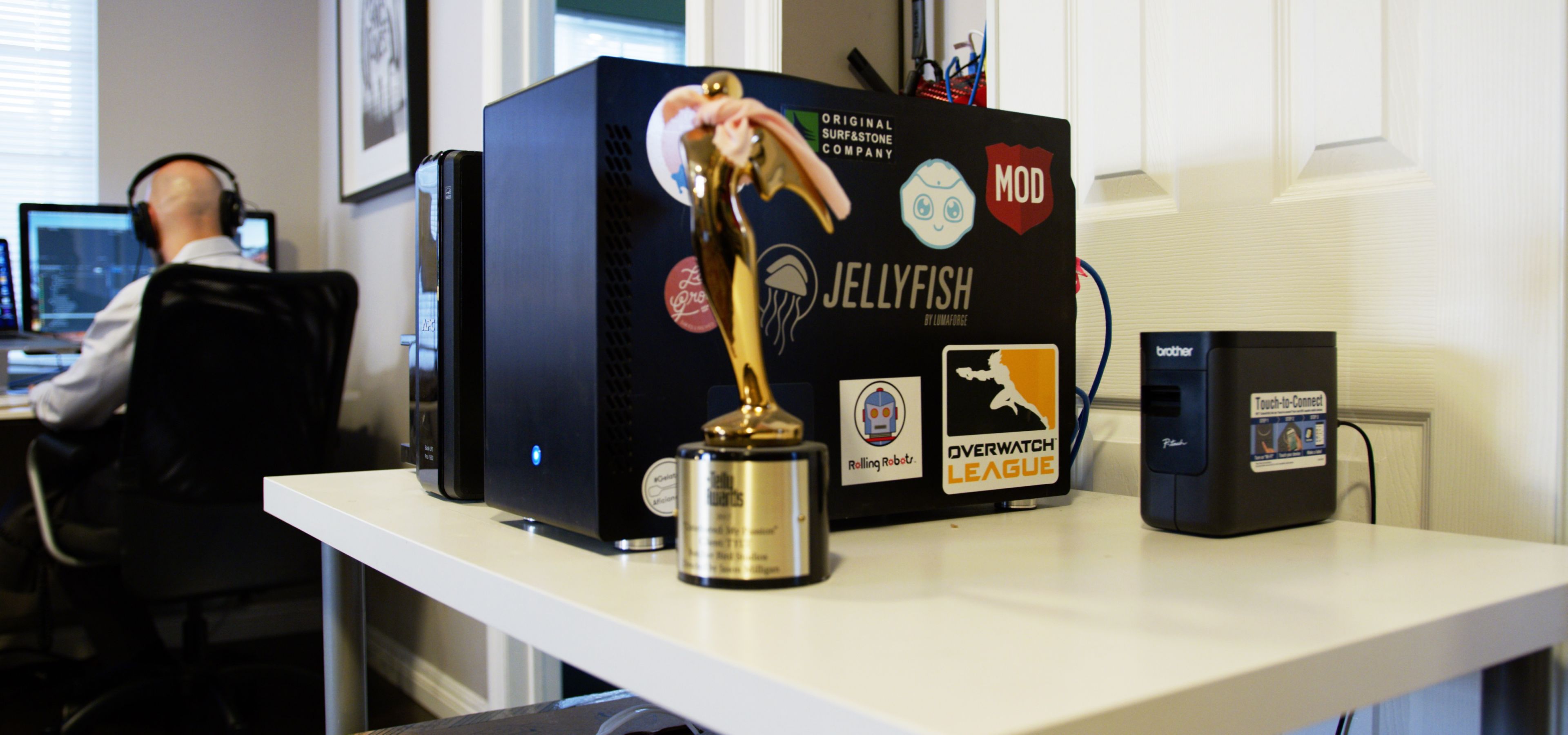
With the clock ticking, I googled “shared editorial server 4k video workflow” and crossed my fingers. I quickly went through the entries and gave a call to “LumaForge,” whose editorial-focused products seemed like they might offer the right solution. Josh, the CEO of the organization, answered the phone. He later revealed to me that he took the call while bottle-feeding his newborn. It was amazing multitasking that spoke well for the future! He informed me that their whole ethos is filmmaker-focused.
I talked him through all the details of the project. We would have a director and two shooters with mission-critical scheduling. All of us would have to also serve as editors at the end of each day. We would need to ingest, edit and output simultaneously. Sam let me know their entry-level platform, the Jellyfish Mobile, was perfect for us and could support up to four (4) editors simultaneously doing exactly what I had just described.
Three days later, I picked up our freshly configured Jellyfish from the LumaForge HQ in LA and then hopped on a plane, along with Shooter/Editor maestros Jason Milligan and Jarrod Wendler (both directors in their own right), to Roswell, New Mexico the very next day.
Everyone a Filmmaker
We had solved the on-site post challenge. But I still wasn’t sure how we’d actually capture all our deliverables with such a tiny production team (our amazing production sound mixer, Todd Steinhauer, would join us in Albuquerque for the long drive to Roswell).
Thankfully, I had worked with our extremely talented agency Executive Producer, Kat Urban, on multiple occasions, and I knew she’d support innovative solutions. She’s one of those people who could parachute into any place on the planet, roll up her sleeves after landing, and cheerfully wrestle a bear while staying on brand and recommending a good restaurant.

All the teams assembled for breakfast at IHOP in Roswell the day before the start of the UFO Festival. I watched as our production team traded taste tests of the ridiculous variety of pancakes, sharing bites with four creatives from Chiat, two clients from Airbnb, and three members of the National Geographic team.
Then it hit me as I looked around the table. I didn’t just have four people on my production team. There were thirteen. I announced my new plan to everyone before the sugar coma hit: “Guess what? We’re gonna meet every night in editorial—right over there in our glorious hotel room at Comfort Suites—and everyone here will download all their cell phone videos and photos from the day!”
Everyone loved the idea. It just made sense. Because now, with 4K video standard on cell phones, everyone’s a filmmaker. Sure, maybe not for Lawrence of Arabia 2, but for social, it’s not only practical but authentic!
Production
 The Roswell UFO Festival is the apotheosis of delightful and whimsical Americana—the type of idiosyncratic gathering that offers hundreds of distinct characters, thousands of stories, and countless camera-worthy moments.
The Roswell UFO Festival is the apotheosis of delightful and whimsical Americana—the type of idiosyncratic gathering that offers hundreds of distinct characters, thousands of stories, and countless camera-worthy moments.
My production team primarily shot with Canon C300 Mk2’s and L-series zooms, though we also deployed GoPros, still cameras, and the latest iPhone cameras. Todd kept us in top shape with broadcast/film-quality sound, which we’d all agreed to deploy for any interviews or live streaming.
I was proud as always of the footage we captured. A doll maker who specialized in creating amazing alien figures grew tearful as she talked about how much meaning she found in her work. A Red Cross worker delighted in showing us the custom-made alien CPR dummy they had created to get people interested in taking classes. Not one but two doggy-piloted UFOs entered the pet/alien costume contest and paraded in front of hundreds of audience members grinning from ear to ear.
But I was also stunned by some of the imagery our agency and clients captured. A beautiful backlit sunset silhouette of our team scouting the desert for live stream locations at the end of the day. A timelapse video of our journey to Bottomless Lakes State Park outside Roswell. Selfies by our Nat Geo host in front of great art that the rest of us never had a chance to see. These moments and hundreds more would have never happened if we hadn’t embraced the reality that anyone with a cell phone has a story and the means to tell it.
We approached our live work in much the same spirit, with a Canon C300 Mk2 streaming the main action, but our myriad supporting cameras telling all the stories around the edges, ranging from our charming Airbnb host’s family to the mischievous kids participating in the human/alien costume show. By the way, for you live stream geeks out there, we were able to maintain streaming bandwidth by bonding multiple cell phone data connections through our Teradek Vidiu Pro and the ShareLink cloud service.
Concurrent Post
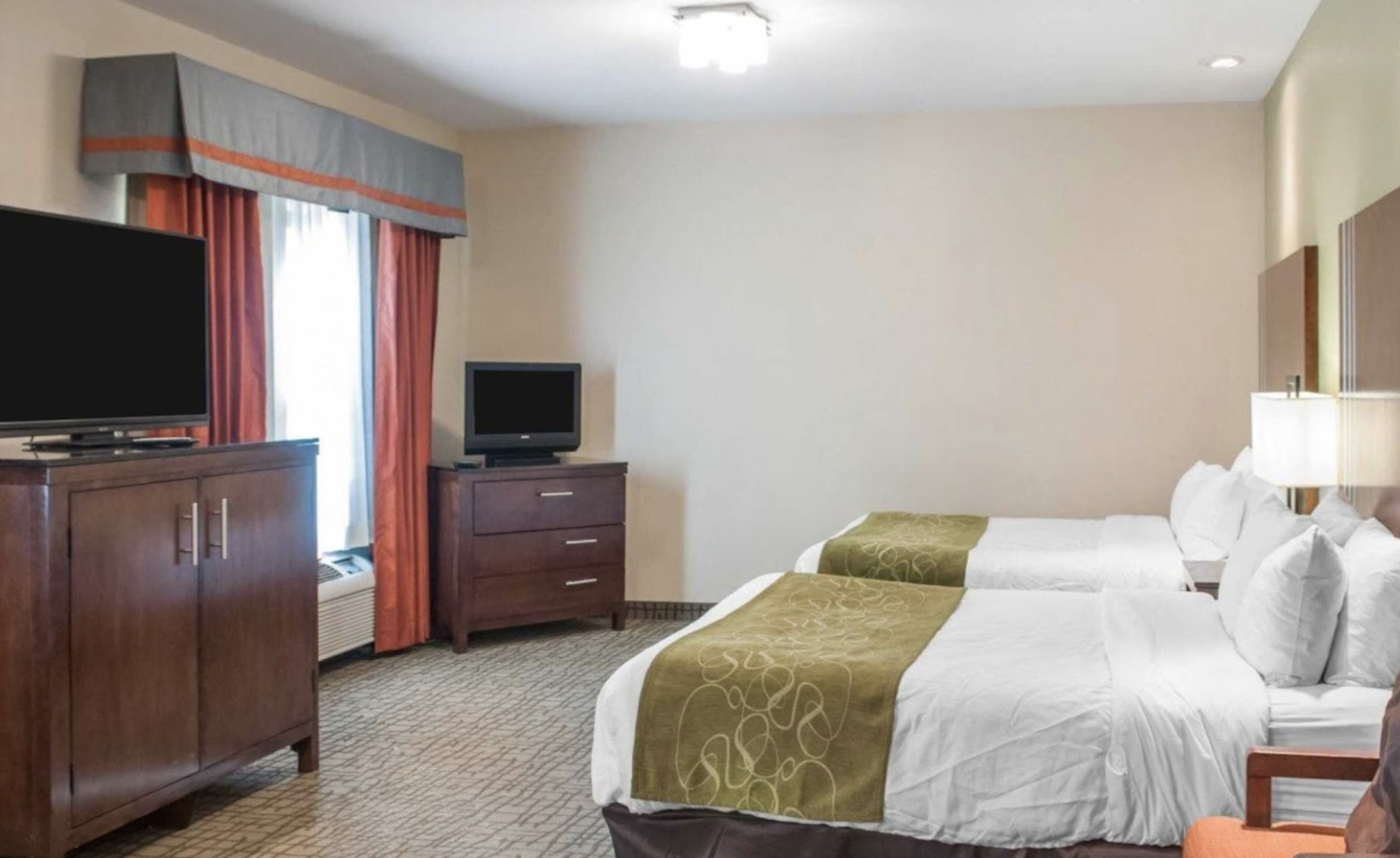
Despite the challenging summer heat and scope of shooting, production was actually a fairly standard filming experience. The real magic happened during our post workflow at the end of each day.
Ten or more of us would gather in Jarrod’s hotel room (he drew the short straw). We had three Apple MacBook Pro laptop computers connected via 10GbE to Thunderbolt converters to the Jellyfish Mobile. The effect was very much like being in college and cramming for exams. But we all embraced it, client, agency, and filmmakers alike, because the pace kept us on the edge of our seats. Or duvet. Or tabletop, if you were the last to arrive.
At any one moment, Jarrod, Jason, or I would be capturing footage and imagery from the C300s, GoPros, SLRs, or one of a dozen cell phones. Another one of us would review footage and images with client. While yet another would be in the midst of editing and reviewing sequences with the whole team. A pizza would arrive, and we’d swap tasks. Now I worked on Jarrod’s sequence while Jason dug up more shots for me to use. And Jarrod outputted material that one of our clients could use for a social media post.
Sure, you wouldn’t want to run a feature film like that, but it absolutely worked as a four-day sprint. All it needed was the willingness of everyone involved to go back to school. And the stacks of late-night pizza boxes really helped set the scene.
Post Workflow Details
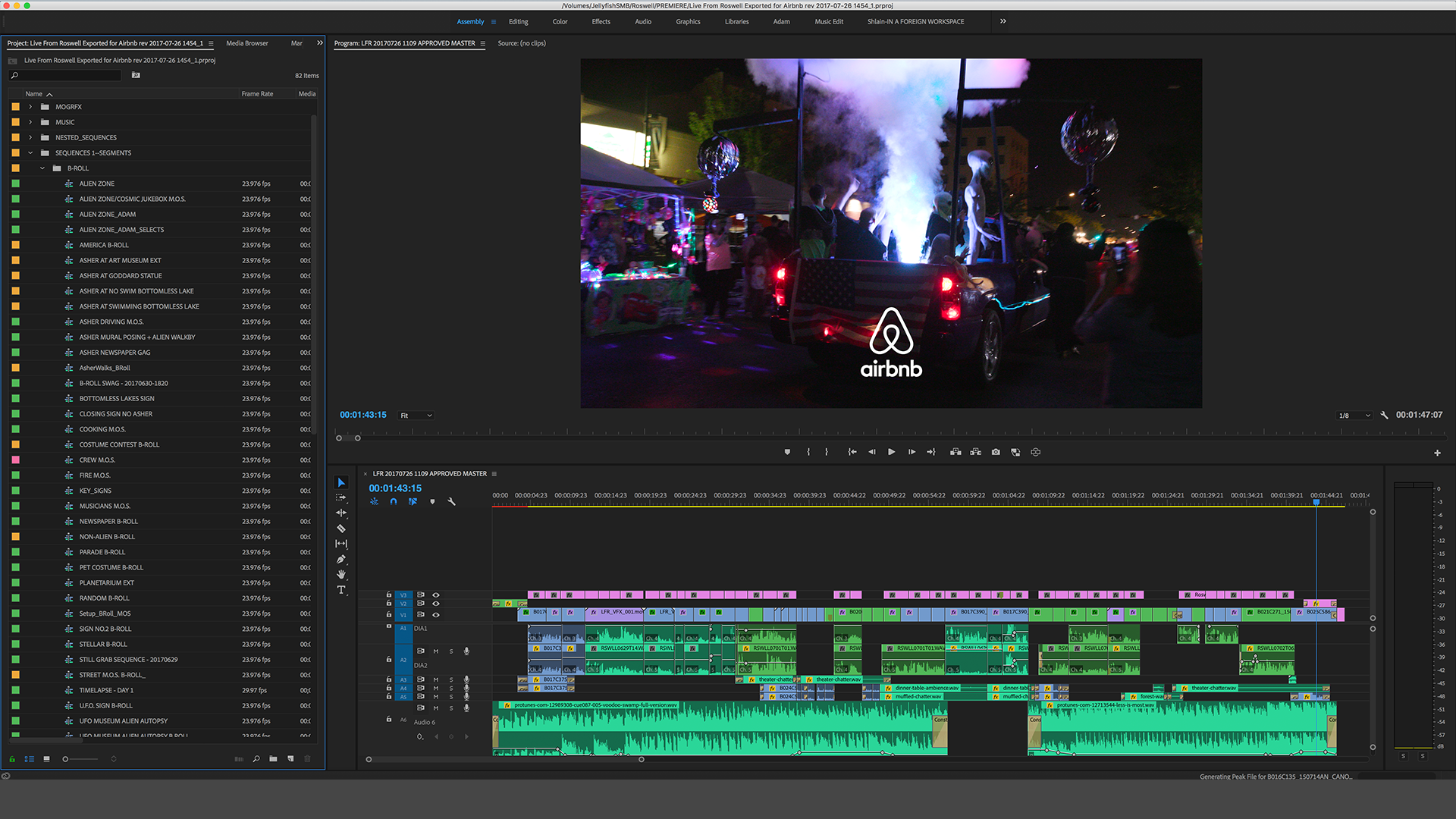
Ingest:
We used Offload by Red Giant because we like the visual reference it provides when transferring cards. It has all the standard checksum verification plus a visual of each clip as it offloads then verifies. The biggest difference for us from our past ingest workflow was that the main ingest “drives” could immediately be used for editing. That took a major step out of the process for us. Of course, we still ran a second and third backup to external drives.
For all the cell phone captures, we just used Apple’s built-in image capture app via lightning cable. And then ran multiple backups after first ingest. Eventually, the extended team would upload cell phone imagery/footage to a shared Google Drive folder each night. We then downloaded from there to the Jellyfish.
Sync:
Todd set up our C300’s with jammed timecode, so syncing by timecode in Premiere was a cinch. Of course, all our ancillary material was shot with wild sound. So, where possible, we worked off of simple clap slates and synced the old-fashioned way for that material—by eye. To simplify the process, we set up sync sequences based on each set of camera cards (Camera A and Camera B). We used simple gaps to separate each clip on the timeline.
Organization:
In the interest of time, we decided to quickly organize our sync sequences by event or interview. In practice this meant yelling out, “who has time to put together the alien abduction panel?” or “you did the UFO library interview—please grab that from the A004/B004 sync and break it out into a new sequence.” From there, an editor would listen and watch the piece at 2x speed. They would quickly throw down markers for interesting bits.
Editing:
We all served as editors on this project. However, my role as director meant I constantly gave out updated priorities based on latest needs from agency/client. Thus, I would yell out something like, “Jarrod, please jump on ingesting the young alien costume portion of the live show.” “Jason, I need the GoPro footage from your cliff jump at Bottomless Lakes.” Ultimately, we got a few extra days to deliver the final companion documentary. We continued the same style of collaboration through editorial back in LA. There, Adam Fair joined us as an additional editor and Jason Milligan switched hats to graphics maestro, tossing out supers and other elements with the same shared efficiency.
Outputs:
The deliveries on this project were staggering. We supported outputting everything from vertical video for Facebook, to square outputs for Instagram, to 4K-mastered uploads for YouTube. Each time, an editor would claim responsibility for that output. They would just duplicate out a new sequence and export it, as fast as possible.
A note on Syncing:
I used to be nervous about overwriting another editor’s changes in a collaborative environment. Instead, we all effortlessly picked up the habit and rhythm of syncing. A little diagonal down arrow at bottom left of screen lights up any time there are new changes available. A red arrow in the sequence tab lights up if another editor opens a sequence while you’re working on it. After finishing a sequence update, we all got in the habit of closing the sequence and then hitting the up arrow to send out our latest changes. The old technology of shouting back and forth across the room worked great and kept our energy up. However, we could have pulled off the same approach while working in separate locations.
Conclusion
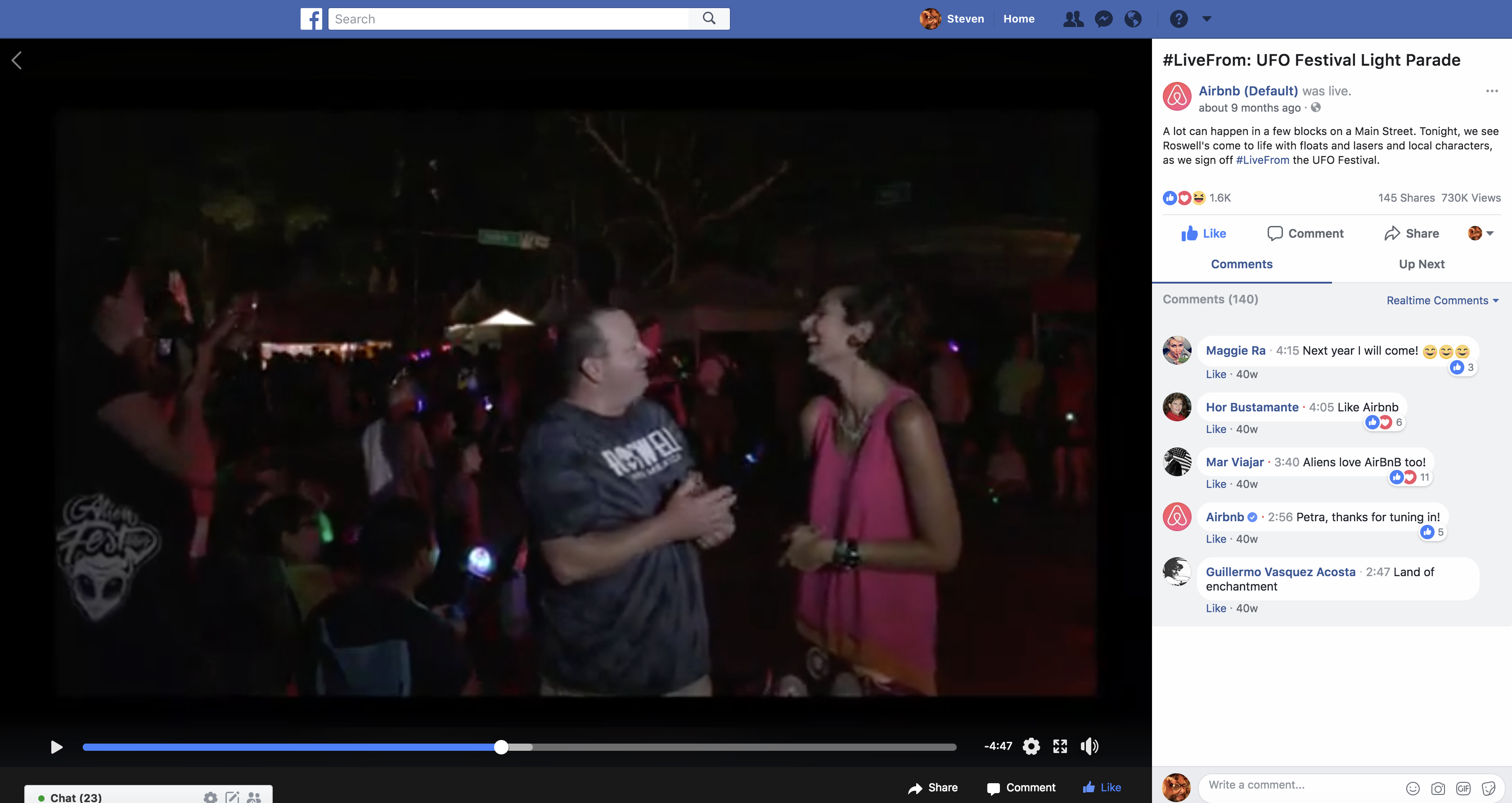
So, how’d we do? Well, the live streamed pilot garnered millions of views, so from that perspective alone, success! But that wasn’t the most important victory to me. For our team, we established a whole new method of real-time collaboration that we took back with us to the Butcher Bird Studios HQ in Los Angeles. Since then, we’ve taken the same Adobe Creative Cloud for Teams/Jellyfish approach on everything from Top Gun-style multicamera shoots on a giant aircraft carrier to some truly insane narrative projects.
Along the way, we’ve kept updating to the latest releases from Adobe. And LumaForge has stayed with us, jumping on the phone and offering real-time remote support via TeamViewer. They have been there when we add new editors and stress-test the Jellyfish in new and unexpected ways. We’re already talking about adding a second Jellyfish. That way, we can always be ready to edit in the field immediately after first capture.
But the biggest challenge we overcame was mindset. We now work faster together. Adobe Creative Cloud for Teams and LumaForge empower us to do just that!

Filmtools
Filmmakers go-to destination for pre-production, production & post production equipment!
Shop Now